| کد مقاله | کد نشریه | سال انتشار | مقاله انگلیسی | نسخه تمام متن |
|---|---|---|---|---|
| 2086265 | 1545531 | 2016 | 8 صفحه PDF | دانلود رایگان |

• The effect of US/MI-S on enzymatic activity was investigated.
• US/MI-S treatment increased the dextranase activity by 171.13% compared to control.
• Vmax and KM of dextranase increased under US/MI-S treatment compared with control.
• US/MI-S could be an effective method to improve enzymes activity in many industries.
The synergistic effects of ultrasound and microwave irradiation sock (US/MI-S) on hydrolysis of dextran catalytic by dextranase were studied. Ultrasound (US) treatments were performed at fixed power of 50 W/40 kHz, and the microwave irradiation shock (MI-S) was applied at different power conditions, of 10–140 W at 2450 MHz at a sock rate of 20 s/min. The hydrolysis of dextran under US/MI-S treatment was significantly higher than those performed under US, MI-S and conventional thermal incubation at all condition studied. The maximum hydrolysis rate was observed when US/MI-S (US of 50 W combined with MI-S of 60 W at a sock rate of 20 s/min for 25 min) was used in which the dextran hydrolysis increased by 171.13% compared with routine conventional heating. Results also showed that, Vmax and KM values of dextranase under US/MI-S treatment were higher than those under US, MI-S and conventional thermal incubation, which indicated that, the substrate was converted into the product at an increased rate under US/MI-S treatments. Kcat and (Kcat/KM) values obtained under US/MI-S treatment were higher than those observed under respective conventional heating. Compared to the enzymatic reaction under US, MI-S, and conventional thermal incubation, dextranase enzymatic reaction under US/MI-S treatment showed decreases in Ea, ΔG and ΔH, however small increases in ΔS value were observed. On the other hand, CD spectra reflected that β-sheet and random coil content were decreased by the mean of the US/MI-s and US treatments and increased under MI-S treatment compared to control. However, fluorescence spectra demonstrated that, degradation rate of dextranase secondary structure was slower than that of enzyme tertiary structure. Therefore, US/MI-S treatment results in reordered secondary structure of dextranase, which was helpful for the improvement of its activity. To the best of our knowledge, this study was the first report on synergistic effects of ultrasound and microwave irradiation sock on industrial enzymes.Industrial relevanceIn order to reduce the industrial cost for the application of enzymes during the sugar manufacturing process, a synergistic effect of ultrasound and microwave irradiation sock (US/MIS) on hydrolysis of dextran catalytic by dextranase was applied. The hydrolysis of dextran under US/MI-S treatment was significantly higher than those performed under US, MI-S and conventional thermal incubation at all condition studied. The maximum hydrolysis rate was observed when US/MI-S (US of 50 W combined with MI-S of 60 W at a sock rate of 20 s/min for 25 min) was used in which the dextran hydrolysis increased by 171.13% compared with routine conventional heating. These results indicated that, the combination of ultrasound and microwave irradiation sock could be a new and innovative method for improving the dextranase activity in many industrial applications including food processing.
Journal: Innovative Food Science & Emerging Technologies - Volume 35, June 2016, Pages 125–132